How to Build Custom Employee Time Tracking Software
Updated: August 27, 2021
Choosing between off-the-shelf and custom software is like ordering pizza from the menu versus creating your own. What the waiter will bring you is going to be delicious, but you won’t be fully satisfied if this is not what you really want.
In this article, we’re going to answer all your questions about custom employee time tracking software development: what it is, how it works, whether you should develop your own tool, and how to implement a time tracking tool in hr systems with employee management.

We provide companies with senior tech talent and product development expertise to build world-class software. Let's talk about how we can help you.
Contact usTable of Contents
Manual vs. automated time tracking methods
So there are two basic time tracking methods, manual and automated. But not a single of them is universally good for every business. Depending on the company size and a business model, some organizations can feel fine using manual systems, whereas others may desperately need automated solutions.
Manual time tracking systems
This time-tested and familiar method is going to be best for smaller organizations and teams working in the same office/ in the same field.
Pros
- Inexpensive compared to automated systems
- Easy to implement and manage
Cons
- Often inaccurate (depending on an employee);
- High possibility of human error;
- Still requires you to calculate payroll and write documentation;
- Doesn’t integrate with other tools.
Automated time tracking software
Automated software tools are going to be better for large organizations that have multiple teams scattered in many different locations.
Pros
- Minimal possibility of human error;
- Transparent performance tracking;
- Automatically calculates payroll and generates reports
- Integrates with other tools
Cons
- More expensive;
- Requires basic PC-user skills for all employees;
- May be harder to implement in remote rural areas.
Whereas both methods have their users, the automated systems are growing in popularity. And if your company is growing, you’ll inevitably hit the wall with manual tracking. When it’s no longer enough to cover your business needs, you’ll have to switch to an automated system, but you’re going to love it.
How does an employee time tracking software work?
Generally, all employee time tracking systems work the same way. User signs up and gets access to all/ some system features (based on the admin rights).
User creates/ selects a project
Admin users have access to more features. They can create projects, add tasks, add other users to the team, and so on. General users can access the projects/ tasks without the right to modify these.
User starts the timer or inputs manually the hours worked
Employees select the project/ task, start the timer when the work begins and stop it when the work ends. Usually, it’s also possible to leave project notes.
Software processes data
The software automatically tracks hours worked and records user data in the timesheet. This information can be later used to generate invoices.
Software generated reports
Besides invoices, it’s also possible to generate other user activity reports. This data can later be used by managers and team supervisors for analytics purposes.
Basic features of an employee time tracking software
Long gone are the times when employee tracking software would solely record the number of hours people spent at the workplace. Contemporary time tracking tools are versatile instruments with a variety of useful functions. Below are some common features of modern time tracking software:
Timesheets
These are the attendance reports that show all the information regarding billable hours (present/absent, time off, holidays, and vacations).
Time tracking
This is the key feature of such software. It captures and keeps the record of total hours spent by the person at the workplace.
Project management features
Besides time tracking, this kind of software usually has additional project management tools, such as assigning tasks, setting deadlines, monitoring overall progress (daily tasks/ weekly, monthly goals).
Automated invoicing
Counting hours and preparing invoices is probably the biggest headache of most managers. Modern time tracking software does that automatically. It might even send invoices to the customer.
Managing users
This feature allows managers to create teams, add/remove users from the groups, and so on. The system has various user types, each with different accessibility levels (e.g. admin user, general user)
Notifications
The system will notify the user every time something happens. For example, if the workday has already started and the user forgot to check in, or if the important deadline is approaching, a notification will ping them.
Reporting and analytics
The ability to organize and interpret the data is just as important as collecting it. That’s why modern time tracking software usually has corresponding features (generating reports, graphs, and so on).
Integration with other tools
Time tracking software integrates with other managerial tools, making lots of things easier. As a result, tasks like accounting, payroll, project management, and so on are greatly simplified.
When it’s better to build a custom time tracking software
Let’s take time tracking for the construction industry as an example.
Supposing, you’re a foreman, a construction site manager, and you have two teams working in different places. You want to find a better means to track their working hours and a more efficient way to prepare documentation.
Also, you could use some monitoring assistance since it’s impossible to be physically present in two places when you need to ensure that both clients are happy with the result. And of course, it would be amazing to have a tool that automatically counts hours worked and generates invoices because this routine work takes up too much of your time. Plus who wouldn’t like being able to track how much workers spend on the materials?
Whereas tracking hours and generating invoices is possible with any time tracking tool, monitoring spending on materials for construction (such as concrete, pipes, sand, broken stone) might be too much for an off-the-shelf software. You’ll probably need to combine several tools and juggle the data back and forth. Or you can have a custom software solution tailored to your specific needs, and it will provide you with all the necessary support and automate the most time-consuming routine tasks.
So how do you know when you should invest in custom time tracking software development and when it’s better to use a ready-made solution? From our experience, you probably need a custom one if…
Your industry is very specific
To automate workflow management in more complicated industries like construction, it’s not sufficient to track time and generate invoices. There are several other important aspects, which you simply can’t cover without a proper customization.
Your business needs are growing
In case you need domain-specific time-tracking, or when some tasks in your expanding business theoretically could be automated, but require custom features, it’s better to have your own tool.
Your current software doesn’t cut it anymore
If your current out-of-the-box software doesn’t fully cater to your needs, or if it solves some of your problems only to some extent, you will benefit from some customization.
You have time to wait
Custom employee time tracking software development requires a lot of time. Depending on the complexity, it can last months or even years, so you have to be willing and ready to wait, as well as to actively participate in the process.
You have the budget
Compared with off-the-shelf software implementation, custom software development is way more expensive. You’ve got to be ready to invest in the team that will have enough expertise to get you covered.
Here’s a little mind map to help you figure it out:
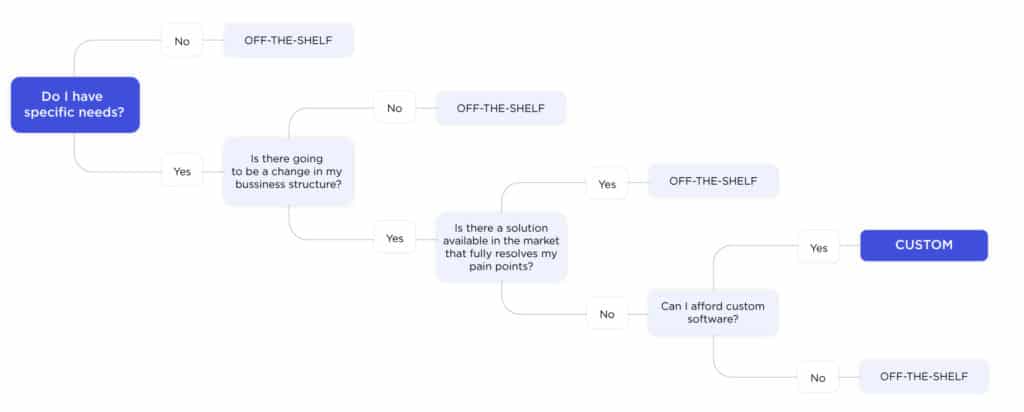
Pros and cons of building a custom time-tracking solution
Custom software development has its benefits and drawbacks. So before you decide to go with this option, take a moment to evaluate your needs and expectations. There are quite a few factors you need to consider while making this choice, both beneficial and not so much.
Let’s start with the pros.
Custom development pros
- It’s custom
As the name implies, your software is going to be tailored to your specific requirements. Your tool is going to have everything you’ll ever want (as long as it’s technologically possible). It’s up to you to decide what features and modules to use. - It’s scalable
If you know your company is going to grow in the near future, or if you’re planning to add more services, rest assured knowing that your custom piece is going to cover that. You’ll just need to request more updates and the team will do it for you. - It’s smooth
Provided that you cooperate with an experienced team and communicate with them constantly, software implementation is not going to disrupt your business processes at all. Your employees won’t even feel the change. - It’s reliable
Another great benefit of having custom software is the instant support you will get from the development team. Most vendors are fully accountable for the tech side of things and they will offer lifelong support and maintenance for their clients. - It’s yours
You don’t need to purchase licenses and you don’t have to adjust to any unexpected changes as it often happens when using most SaaS products. Your software is 100% under your control.
Custom development cons
- It’s expensive
Custom employee time tracking software development requires high upfront investment plus potential extra expenses. Even though it’s going to pay off in the end, this may be too much for some organizations. - It’s a long process
The vendor is going to build a unique solution from scratch, and the more complex the software is, the longer it will take to develop it. Some tools can be created in a few months whereas others may require years. - It does not guarantee success
The whole process is going to take a lot of research and testing. But you can never be sure that it’s going to bring the results you’re hoping for. Like with every other aspect of virtually any business, there’ll always be some degree of uncertainty.
How we built custom time tracking software for the construction industry
Here at Relevant, we’re helping companies around the world build software and scale their engineering teams. One of the companies we’ve worked with is a Norway-based startup Svenn. Their product is a custom time tracking software for the construction industry. The goal for this project, now successfully completed, was to come up with the solution that would track time, automate routine tasks, minimize paperwork and billing delays – all in a single software. Together with the Svenn team, we’ve developed an efficient and super convenient tool that now simplifies the workflow of many construction teams worldwide. Over the past four years, we’ve been constantly adding new features to this product, and today, Svenn is growing into a serious Procore competitor.
Features of Svenn
- Informative and easy to navigate dashboard with a detailed overview of the user’s current projects.
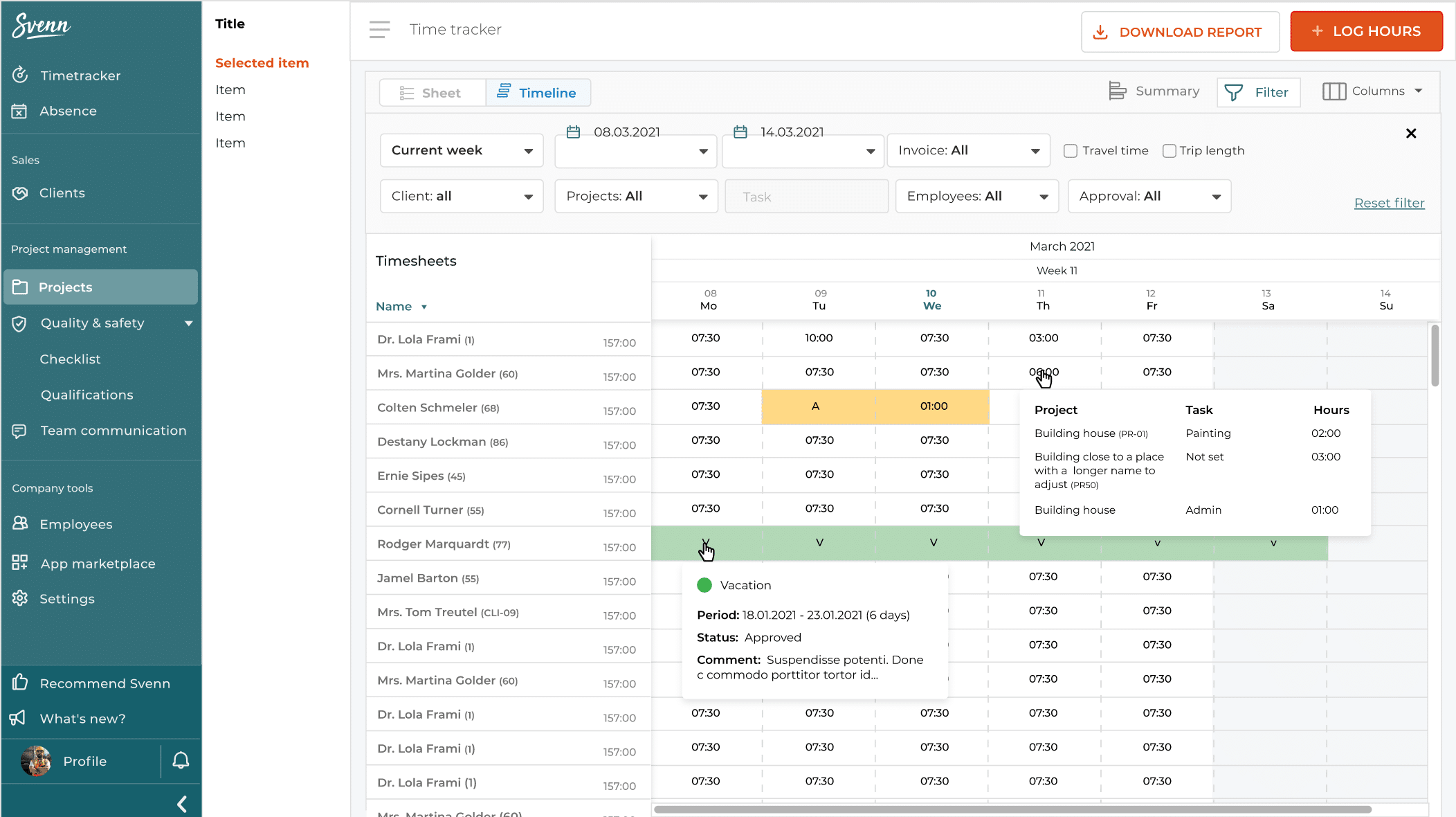
- A set of project management tools for tracking tasks, deadlines, assigned employees, and other project details.
- An accurate time tracker with optional logs (expenses, travel distance, lunchtimes, and so on).
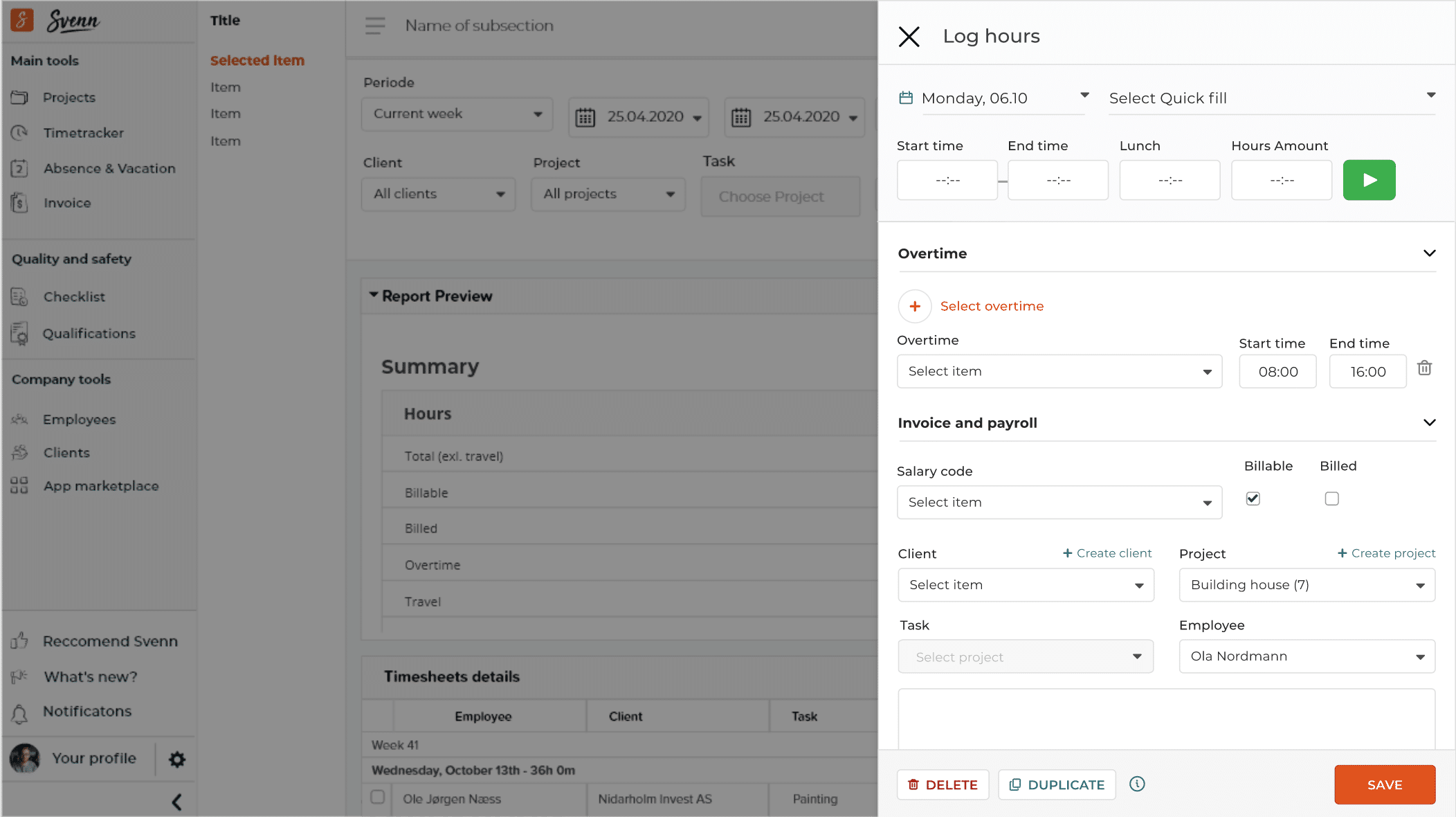
- Custom reports generator with various filtering options and export formats (PDF, .XLS, .CSV).
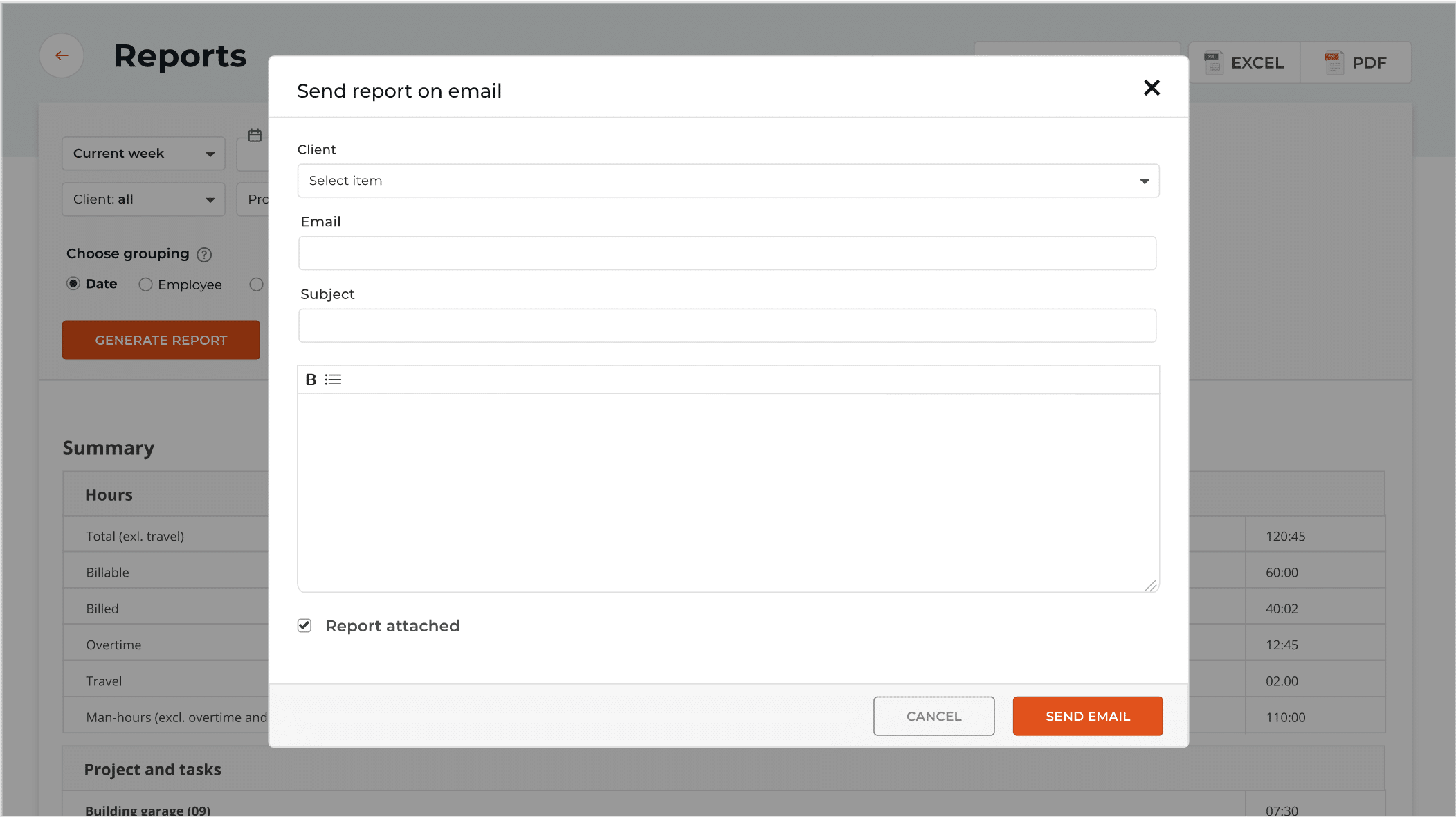
- Invoice manager based on the time tracker and employees’ profiles, which calculates pay automatically and exports payment data to the payroll system.
- Offline mode in mobile apps, with the help of which it’s possible to use the app without internet connection (all the data will synchronize once the device gets connected to the network)
What technologies we used
To build this custom time tracking software, our devs used the following tech tools and solutions:
● Cron – the software utility Cron is a time-based job scheduler in Unix-like computer operating systems;
● AWS RDS – Amazon Relational Database Service;
● AWS S3 – Amazon S3 Object storage;
● AWS SQS – Amazon Simple Queue Service;
● AWS Lambda – Amazon service for running code without thinking about servers;
● AWS Step Functions – build distributed applications using visual workflows;
●Amazon Elastic Compute Cloud (Amazon EC2) – a web service that provides secure, resizable compute capacity in the cloud. It is designed to make web-scale cloud computing easier for developers;
● Elasticsearch – an open-source distributed, RESTful search and analytics engine capable to solve the growing number of use cases;
● Amazon Elasticsearch Service – fully managed, scalable, and secure Elasticsearch service;
● DocumentDB – Amazon DocumentDB (with MongoDB compatibility);
● Kibana – your interface into the Elastic Stack;
● REST API – representational state transfer;
● PHP Framework – software and libraries on the PHP programming language;
● IaC – infrastructure as code;
● Terraform – open-source infrastructure as code software tool created by HashiCorp.
● IOS / Android / Web – presentation layer.
Read also how to hire a dedicated iOs developers.
Time tracking software architecture
We’ve decided to go for microservices architecture – separate individual modules (time tracking, reports, ERP system integration, etc.) to increase overall platform efficiency. Our engineers divided Angular code into custom components and had separate services written on PHP and Node.js to make building and deploying code faster and more reliable. Below is the schema of the Svenn platform.
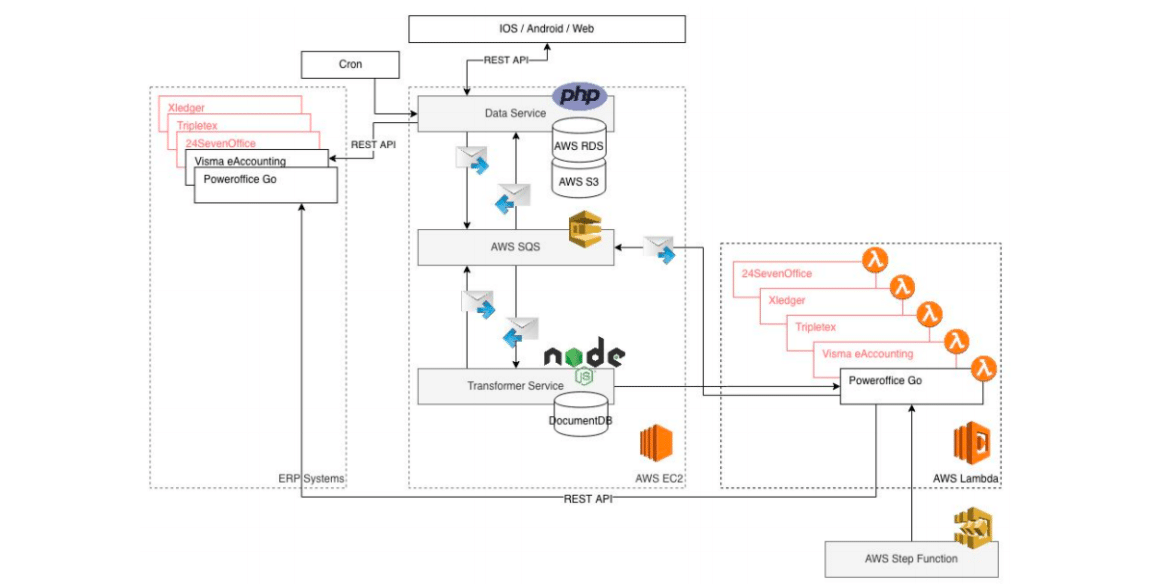
Read also about best offshore software development countries and IT outsourcing to Ukraine.
Top 5 Open Source Time Tracking Software
Do you think you could use time tracking software for your business? Check out our top 5 open source time tracking tools you can use now for free.
#1 Redmine
This is web-based software for time tracking and basic project management. With the help of Redmine, it’s possible to manage multiple tasks and several projects at once. This software is very flexible. It works on different platforms, supports role-based access control, and integrates with version control systems. Multiple languages are supported as well.
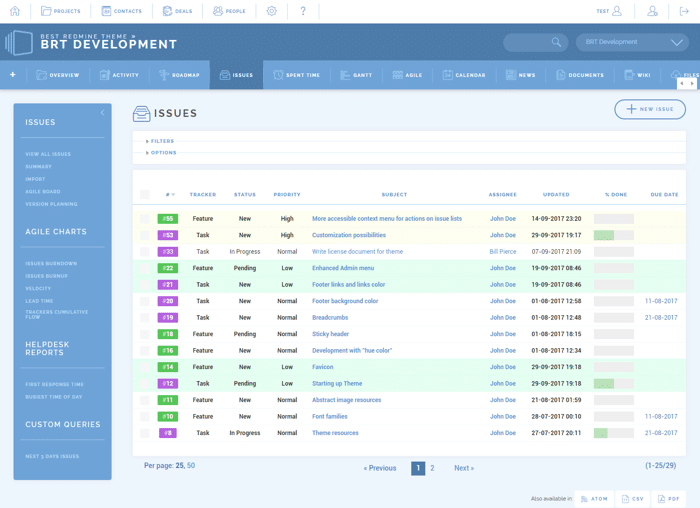
#2 Kimai
Simple software with an unlimited number of users and browser-based interface. You can use it on multiple devices, including mobile. The tool is super reliable and even if you quit your browser, Kimai will still track time. The only way you can stop it is manually. Check out its interface:
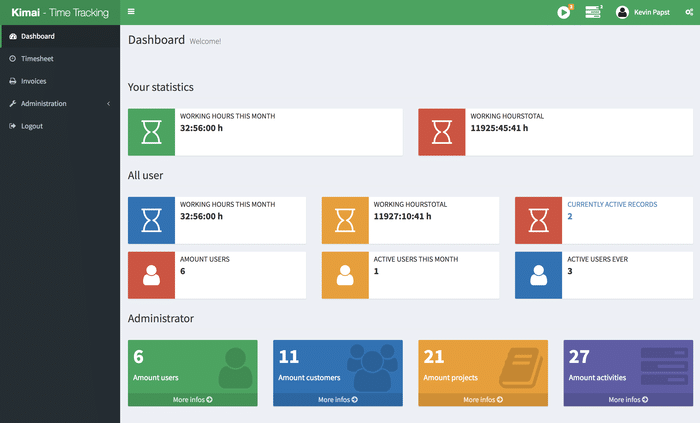
#3 eHour
This time tracking tool helps companies record and analyze the time spent by their workers on different projects. It’s possible to use the hosted version or run software on-premise. eHour supports several languages and currencies, so it’s going to be most useful for companies that operate in various locations around the world. Here’s how it looks:
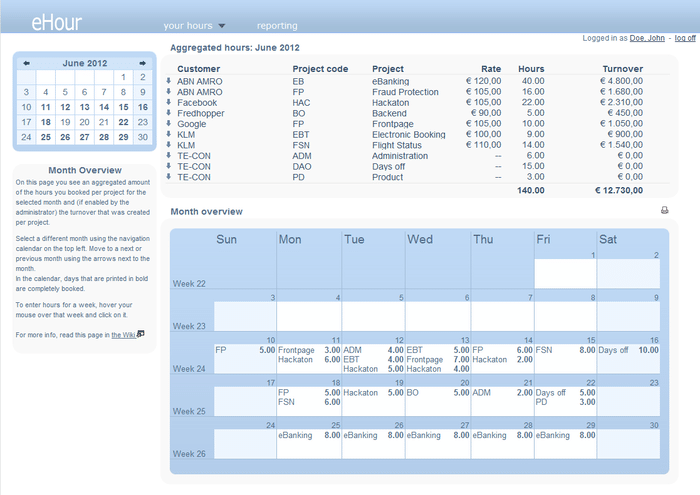
#4 OpenProject
This is a powerful tool with various time tracking features. OpenProject would be great for project-based work, something like design or software development. It follows the team all the way through the project, which is great support for project managers.
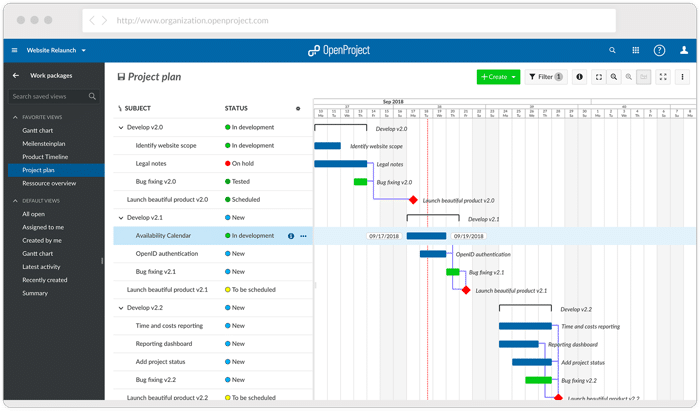
#5 Project Hamster
Project Hamster also tracks the time spent on various tasks. This software will be most convenient for freelancers and individual employees. It’s possible to export or print out the timesheets with activity reporting. This is the Project Hamster’s interface:
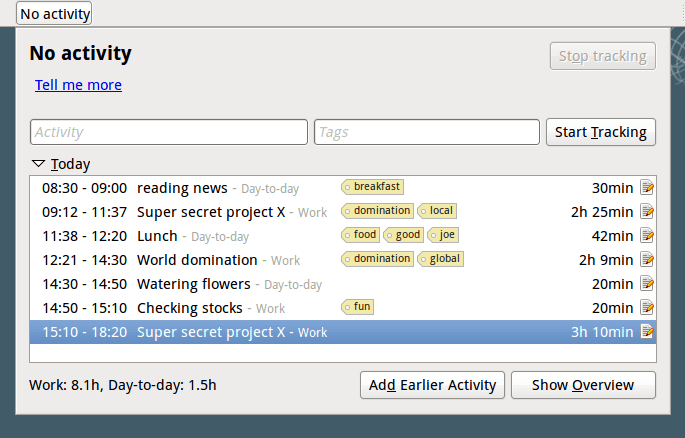
Summary
Overall, it’s a good idea to build a custom employee time tracking solution provided that you know it’s going to simplify your growing business, you are ready to invest, and you have enough time to make it happen. If you are looking for a reliable software engineering team, Relevant can help! Contact us, let’s talk about how to make it happen.
Our core services:
Do you want a price estimate for your project?
Do you know that we helped 200+ companies build web/mobile apps and scale dev teams?
Let's talk about your engineering needs.
Write to us











